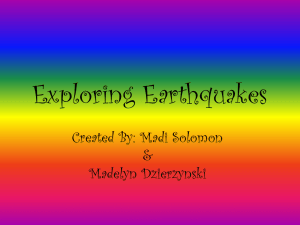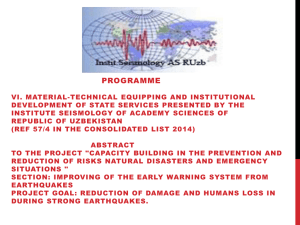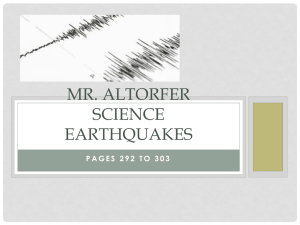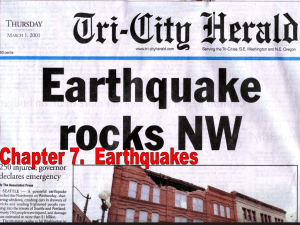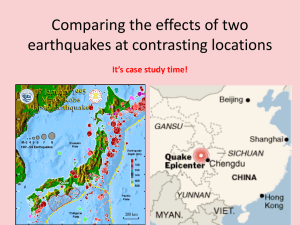Where earthquakes?
advertisement
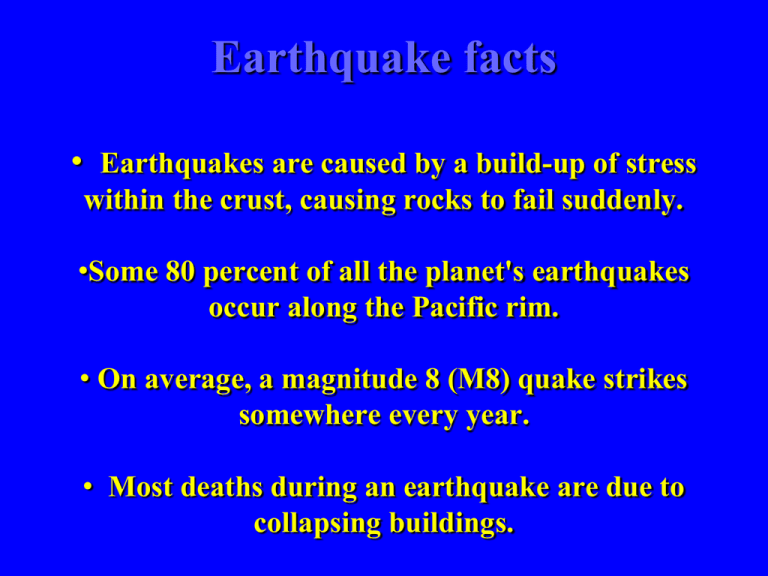
Earthquake facts • Earthquakes are caused by a build-up of stress within the crust, causing rocks to fail suddenly. •Some 80 percent of all the planet's earthquakes occur along the Pacific rim. • On average, a magnitude 8 (M8) quake strikes somewhere every year. • Most deaths during an earthquake are due to collapsing buildings. •Why earthquakes? Where earthquakes? •Why earthquakes? Where earthquakes? Distribution of earthquakes with R.S. mag > 5 from 1980-1990. •Why earthquakes? Where earthquakes? Honshu tsunami videos http://www.youtube.com/watch?v=w3AdFjkl R50&feature=related http://www.youtube.com/watch?v=DSSssHxm4Y&feature=related http://www.youtube.com/watch?v=s8L2kiky Vzk Locating EQs Locating EQs epicenter M=9.0 11 March 2011 5:46:23 UTC focus Faults are where rocks break and move suddenly 30-40 m movement along subduction zone fault in Honshu North American Plate Pacific Plate Tsunami (seismic sea wave) caused by seafloor displacement . Tsunamis slow and steepen (up to 30 m) as they enter shallow water. Tsunami wave predictions Measurement of Earthquakes • Magnitude -an index of the amount of energy released, proportional to amount of ground motion; -Richter Scale - a logarithmic scale: each number represents >30X more energy and 10X more ground motion than preceding number; examples…. Richter magnitude depends on: 1) Separation time (distance) 2) Amplitude (ground shaking) Measurement of Earthquakes • Intensity -based on damage, effects -will vary from place to place Destructive Effects of Earthquakes • Structural damage from seismic waves- • fire • mass wasting - landslides, liquefaction • tsunami (seismic sea waves) Kobe, Japan, 1995 http://environment.nationalgeographic.com/envir onment/natural-disasters/earthquakeprofile.html?fs=video.nationalgeographic.com (National Geographic) http://www.youtube.com/watch?v=SgRry6GZxU o&feature=related(hole in highway) http://www.youtube.com/watch?v=6iNUvlU0SJY (global EQs for 2-month period) http://www.youtube.com/watch?v=reDKxgb_IB Q&feature=related (7.2 quake hits Japan, 2008) http://www.youtube.com/watch?v=7TQDQAesJv M&feature=related (NYC EQ) F =100 lbs 10 lbs/ft2 Stress is force concentrated over an area Types of Stress • Confining A =10 ft2 Plate Tectonics Setting None • Compressive Convergent • Extensional Divergent • Shear Transform Strain is the response of a material to stress • Elastic *Rubber ball *Earthquake • Plastic *Modeling clay *Folded rocks • Brittle *Pencil *Faults Type of Strain depends on: • Temperature • Pressure • Material • Time Plastic flow Folding: plastic response to stress • strain energy used up in folding • no earthquakes Faulting: brittle response to stress •slow or sudden release of small or large amounts of energy •may cause earthquakes Elastic Rebound – causes earthquakes Elastic Rebound Stick-slip Faults • Fault zone may have segments characterized by creep • These may altternate with segments which are stuck (snagged) • As elastic strain accumulates, energy is stored; Subsequently released as large earthquake • Creeping segments store little energy (less dangerous) Stick-slip Faults Seismic Waves • body waves- move only through earth’s interior; -p wave: primary (compressional) wave, fastest, first to arrive at seismic station; 2.4 – 3.2 miles / second ~10,000 mph compare to F-15 ~0.5 miles / second -s wave: secondary (shear) wave -1.8 – 2.4 miles / second - cannot be transmitted through liquid (ex molten rock) P WAVE (compressional wave) S WAVE (SHEAR WAVE) Surface Waves • move only along the surface; • - slowest wave type • Rayleigh, Love waves Surface Waves Determining Distance to Point of Energy Release • Example : thunder and lightning, same source 1) light travels 186,000 miles per sec, instantaneous over 1-25 miles 2) sound travels ~ 1,100 ft per sec Ex. Light-sound time interval of 20 sec indicates lightning was ~ 4 miles away Basic principles of a seismograph… Determining EQ Epicenter S-P interval Record (seismogram) of an earthquake; time separation of arrivals based on wave type. S-P interval shown is ~ 5 minutes. Travel-time graph, used to determine distance from seismic station to epicenter. The location of an epicenter on the midoceanic ridge in the South Atlantic Ocean. S-P time intervals are used from 3 seismic stations. MEASUREMENT OF EARTHQUAKES • Magnitude -an index of the amount of energy released, proportional to amount of ground motion; -Richter Scale - a logarithmic scale: each number represents >30X more energy and 10X more ground motion than preceding number; examples…. Richter magnitude depends on: 1) Separation time (distance) 2) Amplitude (ground shaking) Measurement (cont.) • Intensity - an index of structural damage -based on modified Mercalli Scale I-XII (see Table ); structural damage depends on: -magnitude and duration of EQ -distance to epicenter -structural design -character of surface materials upon which buildings rest. USGS, 2005 San Francisco following the 1906 earthquake; the R.S. magnitude was estimated at 7.8; There were 1,500 deaths. Area in southern Alaska affected by “Good Friday” earthquake of 1964; R.S. magnitude = 9.2, making it the greatest earthquake to strike North America on record (i.e. for ~ the last 2 centuries). Earthquake Prediction • Basis -historical patterns -precursors • Future major and great EQS in California -probability of major quakes (Fig. 15.22) -waiting for the “Big One” (>8 R.S.) • Great quakes in the Midwest…. Statistical predictions for EQs of 7-8 magnitude (major EQs) based on historical patterns and presumption of cyclical behavior involving plate stresses, strain buildup and periodic release (fault rupture). Low Velocity Zone/Asthenosphere Low Velocity Zone Mohorovicic Discontinuity (“Moho) Guttenburg Dis. Divisions of earth’s interior; boundaries are defined by behavior of body (i.e. p and s) waves. Seismic Character of Earth’s Internal Divisions • Mohorovicic Discontinuity (crust-mantle) -defined by abrupt acceleration of body waves, increased rock density/change in composition. • Guttenburg Discontinuity (mantle-core) defined by absorption of s-waves; shadow zone; must be molten (iron) Mohorovicic Discontinuity (“Moho) Guttenburg Dis. Compositional divisions of interior of earth; boundaries are defined by behavior of body (i.e. p and s) waves. Seismic waves, like light waves, will bend, or refract, when they encounter different material P-wave Shadow Zone See animation at: http://earthquake.usgs.gov/learn/glossary/?termID=170&alpha=S S Wave Shadow Zone http://dl.ccc.cccd.edu/classes/internet/geology100/IntroLecture_files/image030.jpg END




